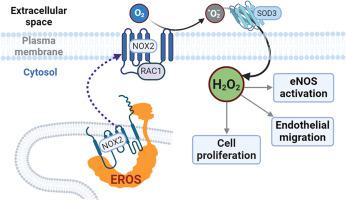当前位置:
X-MOL 学术
›
Redox Biol.
›
论文详情
Our official English website, www.x-mol.net, welcomes your feedback! (Note: you will need to create a separate account there.)
An essential role for EROS in redox-dependent endothelial signal transduction
Redox Biology ( IF 10.7 ) Pub Date : 2024-05-24 , DOI: 10.1016/j.redox.2024.103214 Markus Waldeck-Weiermair 1 , Apabrita A Das 2 , Taylor A Covington 2 , Shambhu Yadav 2 , Jonas Kaynert 2 , Ruby Guo 2 , Priyanga Balendran 3 , Venkata Revanth Thulabandu 2 , Arvind K Pandey 2 , Fotios Spyropoulos 4 , David C Thomas 3 , Thomas Michel 2
Redox Biology ( IF 10.7 ) Pub Date : 2024-05-24 , DOI: 10.1016/j.redox.2024.103214 Markus Waldeck-Weiermair 1 , Apabrita A Das 2 , Taylor A Covington 2 , Shambhu Yadav 2 , Jonas Kaynert 2 , Ruby Guo 2 , Priyanga Balendran 3 , Venkata Revanth Thulabandu 2 , Arvind K Pandey 2 , Fotios Spyropoulos 4 , David C Thomas 3 , Thomas Michel 2
Affiliation

|
The chaperone protein EROS (“Essential for Reactive Oxygen Species”) was recently discovered in phagocytes. EROS was shown to regulate the abundance of the ROS-producing enzyme NADPH oxidase isoform 2 (NOX2) and to control ROS-mediated cell killing. Reactive oxygen species are important not only in immune surveillance, but also modulate physiological signaling responses in multiple tissues. The roles of EROS have not been previously explored in the context of oxidant-modulated cell signaling. Here we show that EROS plays a key role in ROS-dependent signal transduction in vascular endothelial cells. We used siRNA-mediated knockdown and developed CRISPR/Cas9 knockout of EROS in human umbilical vein endothelial cells (HUVEC), both of which cause a significant decrease in the abundance of NOX2 protein, associated with a marked decrease in RAC1, a small G protein that activates NOX2. Loss of EROS also attenuates receptor-mediated hydrogen peroxide (HO) and Ca signaling, disrupts cytoskeleton organization, decreases cell migration, and promotes cellular senescence. EROS knockdown blocks agonist-modulated eNOS phosphorylation and nitric oxide (NO) generation. These effects of EROS knockdown are strikingly similar to the alterations in endothelial cell responses that we previously observed following RAC1 knockdown. Proteomic analyses following EROS or RAC1 knockdown in endothelial cells showed that reduced abundance of these two distinct proteins led to largely overlapping effects on endothelial biological processes, including oxidoreductase, protein phosphorylation, and endothelial nitric oxide synthase (eNOS) pathways. These studies demonstrate that EROS plays a central role in oxidant-modulated endothelial cell signaling by modulating NOX2 and RAC1.
中文翻译:

EROS 在氧化还原依赖性内皮信号转导中的重要作用
最近在吞噬细胞中发现了伴侣蛋白 EROS(“活性氧必需物质”)。 EROS 被证明可以调节 ROS 产生酶 NADPH 氧化酶同工型 2 (NOX2) 的丰度并控制 ROS 介导的细胞杀伤。活性氧不仅在免疫监视中很重要,而且还调节多个组织中的生理信号反应。之前尚未在氧化剂调节的细胞信号传导背景下探索过 EROS 的作用。在这里,我们表明 EROS 在血管内皮细胞中 ROS 依赖性信号转导中发挥着关键作用。我们在人脐静脉内皮细胞(HUVEC)中使用了 siRNA 介导的敲除和 CRISPR/Cas9 敲除 EROS,这两种方法都会导致 NOX2 蛋白丰度显着减少,并与 RAC1(一种小 G 蛋白)显着减少相关。激活NOX2。 EROS 的缺失也会减弱受体介导的过氧化氢 (H2O) 和 Ca 信号传导,破坏细胞骨架组织,减少细胞迁移,并促进细胞衰老。 EROS 敲低可阻断激动剂调节的 eNOS 磷酸化和一氧化氮 (NO) 的生成。 EROS 敲低的这些影响与我们之前观察到的 RAC1 敲低后内皮细胞反应的变化惊人地相似。内皮细胞中 EROS 或 RAC1 敲低后的蛋白质组学分析表明,这两种不同蛋白质丰度的减少导致对内皮生物过程的影响很大程度上重叠,包括氧化还原酶、蛋白质磷酸化和内皮一氧化氮合酶 (eNOS) 途径。这些研究表明,EROS 通过调节 NOX2 和 RAC1 在氧化剂调节的内皮细胞信号传导中发挥核心作用。
更新日期:2024-05-24
中文翻译:

EROS 在氧化还原依赖性内皮信号转导中的重要作用
最近在吞噬细胞中发现了伴侣蛋白 EROS(“活性氧必需物质”)。 EROS 被证明可以调节 ROS 产生酶 NADPH 氧化酶同工型 2 (NOX2) 的丰度并控制 ROS 介导的细胞杀伤。活性氧不仅在免疫监视中很重要,而且还调节多个组织中的生理信号反应。之前尚未在氧化剂调节的细胞信号传导背景下探索过 EROS 的作用。在这里,我们表明 EROS 在血管内皮细胞中 ROS 依赖性信号转导中发挥着关键作用。我们在人脐静脉内皮细胞(HUVEC)中使用了 siRNA 介导的敲除和 CRISPR/Cas9 敲除 EROS,这两种方法都会导致 NOX2 蛋白丰度显着减少,并与 RAC1(一种小 G 蛋白)显着减少相关。激活NOX2。 EROS 的缺失也会减弱受体介导的过氧化氢 (H2O) 和 Ca 信号传导,破坏细胞骨架组织,减少细胞迁移,并促进细胞衰老。 EROS 敲低可阻断激动剂调节的 eNOS 磷酸化和一氧化氮 (NO) 的生成。 EROS 敲低的这些影响与我们之前观察到的 RAC1 敲低后内皮细胞反应的变化惊人地相似。内皮细胞中 EROS 或 RAC1 敲低后的蛋白质组学分析表明,这两种不同蛋白质丰度的减少导致对内皮生物过程的影响很大程度上重叠,包括氧化还原酶、蛋白质磷酸化和内皮一氧化氮合酶 (eNOS) 途径。这些研究表明,EROS 通过调节 NOX2 和 RAC1 在氧化剂调节的内皮细胞信号传导中发挥核心作用。
















































 京公网安备 11010802027423号
京公网安备 11010802027423号